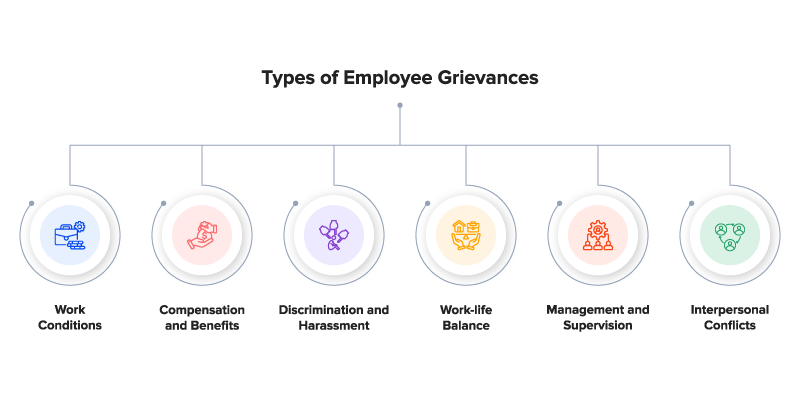Grievance Policy Template
Download Grievance Policy Sample PDF
Table of Contents
As an HR professional or employer, managing grievances effectively and supportively is essential to prevent unnecessary escalations leading to employee frustration and negative feelings. Implementing a grievance policy enables you to identify unacceptable practices and rectify them. You can download our policy template in PDF format.
This Policy Provides the Following
- How employees can beneficially voice their complaints.
- The nature of complaints that are included in the definition of a grievance.
- The process with which any employee can file a grievance.
- The rights and responsibilities of the employee who is filing the grievance.
- The rights of the employee against whom such grievance is filed.

What is a Grievance Policy?
A grievance policy provides employees a formal way to communicate and file their complaints with the organization. This can be related to employment or other aspects. Some of these complaints include workplace conflicts and compensation and benefits.
When a clear, well-structured grievance redressal policy helps in maintaining a positive and productive work environment. With this, employees have a channel to express their work-related issues and identify problems in the organization. It is now the organization’s responsibility to solve the concern, if not, employees can always take the matter into their hands by legal documentation.
An HR professional not only designs an effective policy but also conducts an investigation for the complaints raised. They also provide advice on the outcomes of the complaints.
Some of the real-life examples of scenarios where a grievance policy comes in the picture are mentioned below.
- Workplace Harassment
- Discrimination
- Unfair treatment
- Unsafe working conditions
- Breach of contract
- Bullying or intimidation
- Whistleblower concerns
- Retaliation

Get a Free Employee Grievance Policy Template
Implementing an employee grievance policy has many benefits. This includes employee satisfaction and increased productivity. We have the sample template ready to use template; please check out the template below to help you implement this policy effectively.
According to section 9C of the Industrial Disputes Act, 1947 of India, it is mandatory to form a Grievance Redressal Committee (GRC) in an organization having at least 20 employees to resolve any conflicts/disputes between employees.
Purpose
Satisfaction and engagement between employees are of extreme priority for “Name of the Company”. The primary purpose of this grievance redressal policy is to give employees the right to voice out their complaints.
To ensure a beneficial and comfortable work environment, “Name of the Company” encourages employees to discuss their problems through a transparent grievance procedure. This allows us to provide a supportive and friendly working environment.
Scope
The policy extends to every employee of “Name of the Company” irrespective of the post or status.
Definition
An employee grievance is a problem or complaint regarding the work, company culture, or colleagues, including their management. Any communication for the purpose of gaining clarification is not included in the employee grievance redressal process.
Employees can file grievances for the reasons mentioned below.
- Workplace harassment
- Health and Safety
- Employee behavior
- Unsafe working conditions
From the above-mentioned reasons, the list is not detailed. It is advised to all the employees of the form to address less important issues informally before they escalate.
Rights and Responsibilities
Any employee filing a complaint against any issue can
- contact their immediate supervisor or HR department
- submit an application describing the circumstances in detail
- and file a plea against any formal decision
The person who is the subject of the complaint has the right to
- receive a copy of the accusations
- appeal on any formal decision
The company is required to
- Organize a structured grievance policy for employees
- Communicate the process
- Analyze without bias
- Treat all employees equally
- Preserve anonymity
- Establish a secure working environment
- The company should not take any negative or harmful actions against the employee who filed the grievance
Procedure
Report to the Immediate Superior/“Job Title”
The complaint should be first submitted to the direct supervisor. The supervisor should try to resolve the matter. In case when the employee wants to complain about the supervisor, they should first discuss the matter and resolve it between them. The problem should be solved as quickly as possible in an informal meeting. If the process is not successful, they should take the matter to the HR head and cooperate with all the procedures.
Report to the HR Head
If the employee and supervisor are unable to fix the dispute, the case should be transferred to the HR head. It is the HR Head’s responsibility to gather all information and conduct an investigation.
If the situation involves sexual misconduct or theft, the employee has the option to file a complaint outside of the company.
On receiving the complaint, the company will follow the procedure given below.
- Request the employee to complete the employee grievance policy form.
- Analyze the matter clearly by discussing it with the victim.
- Send a copy of the charges to the accused employee.
- Arrange a formal meeting.
- Interrogate without bias and ask for help whenever required.
- Keep all of the employees involved up to date.
- Communicate the decision to all the employees involved in the process.
- Take corrective measures.
- Extra information should be acquired, and more inquiry should be conducted in the case of an appeal.
- Keep a record of the same.
Note that the procedure may vary according to the grievance’s nature.
Exceptions
If there are any changes in the policy, it has to be approved by the HR head.
Non-compliance and Consequence
All the employees are advised to restrict themselves from sharing their personal grievances with other employees. This is because it causes distraction from work when such topics are discussed in the workplace. Note that this also disrupts all business activities. This policy is structured for employees to submit their grievances through proper channels.
What are the Types of Employee Grievances?

There are different types of employee grievances, which are mentioned below. They are categorized by their types based on the nature and issues they address.
Work Conditions
Work conditions relate to the physical conditions of any workplace. This includes health safety standards and workplace environment.
Compensation and Benefits
Compensation and benefits grievances include conflicts related to the pay scale and compensation issues. This also includes bonuses and health insurance plans.
Discrimination and Harassment
It is related to unfair treatment that can be because of gender or religion. It includes all forms of harassment, which can be sexual or psychological.
Work-Life Balance
Work-life balance issues involve conflicts on overtime or inflexible work schedules. It can be anything that affects an employee’s ability to balance between work and personal life.
Management and Supervision
Management and supervision concerns related to poor management practices and abuse of authority. Lack of communication and favoritism are also included in this.
Interpersonal Conflicts
There are problems between colleagues or employees and the management that affect the working environment. This includes personality clashes or communication problems.
What to Include in Your Employee Grievance Policy
When you are creating your organization’s grievance redressal policy, make sure you include all the key elements. This is to be managed by both the HR department and employees of the organization.
Definition of Grievance
The policy should specify the definition of grievance. Some of the issues are mentioned below.
- Harassment
- Systemic Discrimination
- Unfair treatment
- Safety concerns
- Violations of company policies
Procedures for Filing a Grievance
Mention the steps employees need to take when they are filing a grievance. This should also include any evidence or information an HR should contact.
Confidentiality
Give assurance to the employees that grievance submissions will be handled confidentially. This is done to protect the privacy of those who are involved.
Investigation Process
This section provides clarity on who will be involved in the process. It also includes how the company will respond to the complaint and evaluate the same.
Resolution and Decision-Making
Provide information on how the decision will be taken when there is an investigation. Try to ensure that the policy is committed to treating all employees equally.
Appeals Process
There are chances that an employee is dissatisfied with the resolution, they can appeal the decision and process.
Anti-Retaliation Policy
Please be aware that the company forbids retaliation against employees who file a grievance. Additionally, it prohibits any employee from participating in an investigation or offering support related to the grievance.
Best Practices for Creating Grievance Redressal Policy
When you start writing your organization’s employee grievance procedure, make sure it includes all the information that everyone involved needs. Some of the practices in creating a grievance redressal policy are mentioned below.
- Provide a clear definition of the word grievance and what is included in it.
- Mention the steps to be taken when an employee wants to file a grievance. This includes what form to use and whom to contact with evidence.
- That should be confidentiality in the grievance policy. Ensure that this commitment is maintained strictly to process all the parties involved.
- You can provide information on what kind of resolutions can be expected. Make them understand how the decisions will be taken from the investigation conducted.
- Communicate to the employees on how they can appeal the decision if they are not satisfied or happy with the resolution. Also, mention the process if they want to take the complaint further.
- It is very important to establish a non-retaliation policy. This will make sure that employees can raise grievances without any fear or judgment.
- Keep records of all the grievances and resolutions so that accountability and transparency are maintained.
- Communicate the policy to all the employees to ensure awareness about the process and policy. Make the policy easily accessible to all of them from an employee’s self-service portal or handbook.
How to Customize the Grievance Policy Template?
By using a standardized employee grievance form, it makes it easier to gather all the relevant information from your employees. With this form, you can track the status of their complaints. This will also simplify the process of documenting the grievances and accounting.
Customizing the grievance redressal policy template to fit your organization’s needs is important. This will ensure proper and effective conflict resolution and employee satisfaction. Below is a step-by-step guide to help you understand how to customize the policy.
- Understand the purpose of the grievance policy
- Identify key components to include in the form
- Define clear timelines
- Create the decision-making procedure
- Include rights and responsibility
- Review and adapt to the existing templates
- Ensure proper compliance with legal requirements
- Communicate the policy
A proper grievance policy template is important for establishing an employee-friendly grievance redressal process. The policy template is made to ensure that the employee’s complaints and issues are heard and handled appropriately.
factoHR offers an all-in-one HR software solution that can automate HR-related tasks. With factoHR’s software solution, you can streamline grievance management and allow businesses to focus on maintaining a positive work environment.
Explore HR policy templates to streamline your workplace management:
Disclaimer
This policy template is meant to provide general guidelines and should be used as a reference. It does not take into account all relevant local, state, or federal laws. It is not a legal document. The author or factoHR will not assume any legal liability that may arise from the use of this policy.


